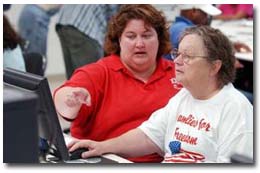
Patricia Ezell, left, assists Marcia Standley with a computer task last week in Monroe. ULM is training teachers from the rural parishes on some the latest agricultural software.
Wanda Ashley, April McLeod and Marcia Standley are comfortable in the country.
All science teachers in rural areas, it's where they work, live and play. So for these teachers, and many others in northeastern Louisiana, science often translates into agriculture - a major industry in rural areas.
Through a $1.2 million grant at the University of Louisiana at Monroe, these teachers will be learning to integrate science, technology and agriculture, and teach it to their students.
Ashley takes off her rubber boots and treks through a soy bean field barefoot. She stares intently at the screen of a small global positioning system unit hanging from her neck.
The boots are leaving a blister, so she leaves them in the row beside her as she takes a reading of the soil temperature with device called a data logger. "I don't like shoes," she said, logging the information and wrapping a plastic bag around the leaves of one soy bean plant in order to measure transpiration.
The information will help her students at Fort Necessity Junior High, she said, because after they've applied these techniques in the classroom, they'll understand the worries that keep their parents up at night during planting and growing season.
"They may be able to help," Standley, a teacher at Mangham Junior High, adds. She's been teaching for 30 years, "and I have cotton growing in my backyard."
It touches all their lives, McLeod said, especially with the pressure brought on farmers to produce.
They stand in the mid-morning sun, wiping sweat from their brows. McLeod teaches at Cherry Ridge Elementary, and has seen that pressure at work. They'll be taking the data they collect, Patty Watts with ULM said, and entering the information on a computerized table to decipher how different growing conditions will affect the plants.
But they'll be taking knowledge back to their classrooms, Standley said, along with GPS, data loggers, and other hard and software provided by the grant. Her students, she says proudly, will be able to tell a farmer the moisture level in the soil.
"They'll go home and see cotton in the ground," Ashley said, pausing to put her shoes back on before stepping out of the soft soil of the field. They'll make the connection between the science book and the science field. "And I can call Marcia and compare notes."
Watts added that ULM was one of 12 grants funded out of 126 applicants. "We actually got the largest award," Watts said, and out of a fairly impressive field, including UCLA and Lawrence Hall of Science at Berkeley.
©The News-Star
This article was published by The News-Star on June 21, 2004.
|